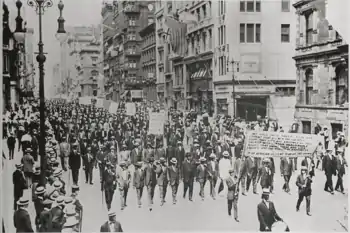Hutchens Chew Bishop | |
|---|---|
| Born | 1859[1] |
| Died | 17 May 1937 (aged 77–78)[3] |
| Occupation | Priest in The Episcopal Church |
The Reverend Dr. Hutchens Chew (H.C.) Bishop (1859[1] - May 17, 1937[3]) was an Episcopal priest who spent most of his career in New York City. He was rector of St. Philip's Episcopal Church in Harlem for 47 years. The church is the oldest black Episcopal parish in New York. The church was founded by abolitionists who laid the first stone in 1819.
He was born in Maryland, the son of William Henry Bishop III (1824-1906) and Elizabeth Chew Bishop (d. 1886), into an old and respected Episcopal family.[1] His grandfather, William Bishop (1802-1870) was one of the twelve wealthiest men in Annapolis.[4] His great-grandmother was Charity Folks, a notable Annapolis woman who lived there both as someone's property, a slave, and a property owning free woman.[4] In Protest and Progress: New York's First Black Episcopal Church Fights Racism, author John H. Hewitt writes,[1]
For many years his ancestors were prominent in St. James Church in Baltimore. His father and older brothers and sisters were among the upper-class blacks who established the second congregation of black Episcopalians in the city, the Chapel of St. Mary the Virgin, in 1867. [This] became the church of Baltimore's aristocrats of color.
He was the first black student admitted to the General Theological Seminary in New York. He graduated in 1881 and was ordained on April 24, 1882.[5] He became rector of St. Mark's Church in Charleston in 1883.[1] Hutchens was different than the majority of his minister peers. Historian William M. Welty comments that Dr. Bishop was a city boy, raised in an urban environment. Also, he and his parents were all free, and as the first black student in theology school, he was educated with whites.[1]
He married Estelle Gilliam of New York, a member of one of the most socially prominent black families, and of the St. Philip's congregation, in 1885.[1]
On January 1, 1886,[5] he became rector of St. Philip's Church in New York City. He would continue in this role for the next 47 years, until 1933.[6]
His son, Shelton Hale Bishop (1889-1962), served as rector of the same church, with a dignified career in his own right.[6]
In 1910, Dr. Bishop worked with prominent Harlem businessman John Nail to purchase real estate for St. Philip's. White sellers were less likely to sell to a black man, so Dr. Bishop passed for white so as to complete the sale.[4] All in all he purchased the land to build the current location of St. Philip's Church, along with 10 apartment properties.[7][4] The state's first Black registered architect, Vertner Woodson Tandy, was commissioned by Dr. Bishop to design the new church building.[7][2]

In 1917, Dr. Bishop served as president of the historic Silent Parade, along with fellow New York clergy Rev. Dr. Charles D. Martin, who served as secretary.[9] Dr. Bishop's church, St. Philip's, served as the coordination center for planning activities.[4] He marched along with W.E.B. Du Bois, James Weldon Johnson, and businessman John Nail.[8]
References
- 1 2 3 4 5 6 7 Hewitt, John H. (2000). Protest and Progress: New York's First Black Episcopal Church Fights Racism. Taylor & Francis. ISBN 9780815334729. Retrieved 1 August 2017.
- 1 2 "St. Philip's Protestant Episcopal Church - Landmarks Preservation Commission report" (PDF). Neighborhood Preservation Center. July 13, 1993. Retrieved 31 July 2017.
- 1 2 "The Living Church Annual: The Yearbook of the Episcopal Church 1938". Google Books. Morehouse Publishing Co. 1938. Retrieved 31 July 2017.
- 1 2 3 4 5 Milward, Jessica (15 December 2015). Finding Charity's Folks. University of Georgia Press. ISBN 9780820348797. Retrieved 31 July 2017.
- 1 2 Bragg, Greg Freeman (1922). History of the Afro-American Group of the Episcopal Church. Church Advocate Press. Retrieved 31 July 2017.
- 1 2 "Shelton Hale Bishop Collection - Biographical/Historical Information". NY Public Library Archives. Retrieved 31 July 2017.
- 1 2 "Happy 100th Birthday NAACP: New York Landmarks of Black Greatness". Huffington Post. 14 July 2009. Retrieved 31 July 2017.
- 1 2 "Silent Protest parade on Fifth Avenue, New York City, July 28, 1917, in response to the East St. Louis race riot". NY Public Library. Retrieved 31 July 2017.
- ↑ "The NEGRO SILENT PROTEST PARADE organized by the NAACP Fifth Ave., New York City July 28, 1917" (PDF). National Humanities Center, Research Triangle Park, NC. National Humanities Center. 2014. Retrieved July 28, 2017.